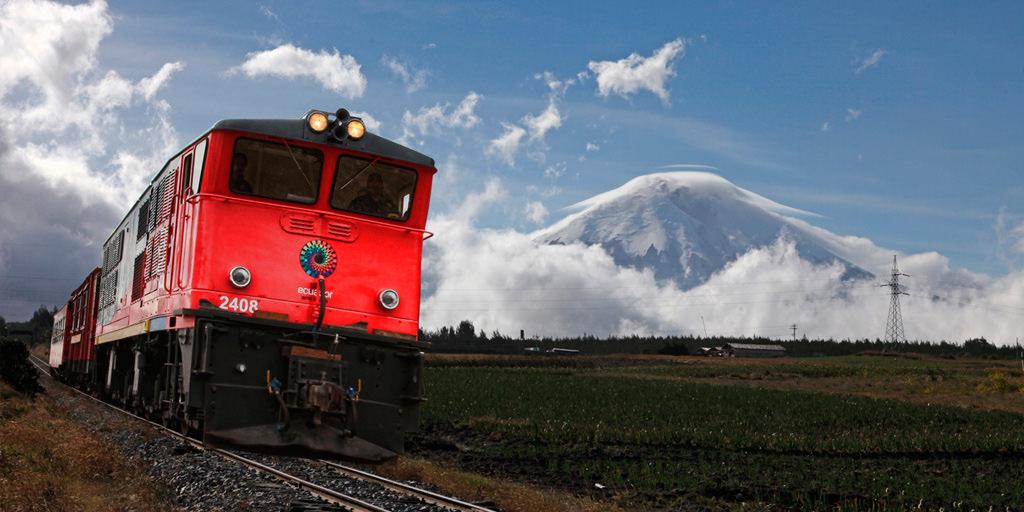Tren de los Volcanes – Ecuador
Tren de los volcanes: A train ride to remember across the most stunning landscapes of the Ecuadorian Sierra.
My ride aboard Tren Ecuador through the Tren de los Volcanes (Train of the Volcanoes) railways begins one chilly and rainy morning at Chimbacalle Station in the southern part of Quito city. It actually started before embarking on the recently remodeled Ecuador Railways Coach. If you’re staying at the north or north/central part of the city. You will probably find out that getting to Chimbacalle station might be a bit of a jounrey itself. The most effective way though, is taking the most used city trolley in Quito. Which crosses the city from North to South, also known as El Trole. There are various stations across the city, and the trolley runs across 10 de Agosto Avenue. The moves in into Guayaquil street into the historical centre and then all the way south through Pedro Vicente Maldonado Av.
The trolley stop for the train station is conveniently called, Chimbacalle, from there you will have to walk a small block north and then you will get to a small steeped street that leads you right into the door of legendary Chimbacalle Train Station. it took me approximately 50 minutes in total to get to the train. Starting at the main station of the trolley bus “Estacion La Y”. The beauty of it all is that Chimbacalle Train Station was the very first station opened by president Eloy Alfaro back in 1908 and the same where the very first train arrived in from Guayaquil into the capital city. This is a symbol of national unity, as history books put it.
Route – tren de los volcanes
I watch the first train leave from the station, the sound of the whistle and the and the machinery on the electro-diesel engine gets us all excite and eager to board. The journey is programmed for 8 am, but the staff requires you to be there 30 mins early for the check in, so we wait patiently. Being a solo traveler for this occasion, it becomes particularly easy to talk to fellow travellers.
This is how I meet Edwin, a Quiteno radio host who remembers with me the times when the train rides were less comfortable a you could actually travel on the roof of the train. Once aboard the train, our guide Victor explains that the new train coaches were brought from Sweden. The coach design is quite comfortable, with a table meant for four travelers on each side, so you can share the ride in the company of other travelers, if the train is full.
The first stop is Tambillo station, and on the way you get to witness how life goes for the southern barrios of Quito. Mainly industrial in nature. Walkers stop to watch the train go by from the streets in awe and smiling, I guess a similar reaction to those watching the train go by more than a century ago. Its is actually quite impressive to witness how far the southern part of the city extends to, I seems like a completely different city.
Guide Victor explain that the sign language used by the “brekeros” (a term used for the train brakeman) is the very same used by the first brekeros when Eloy Alfaro inaugurated the railway, a nice thought to have in mind for the journey.
Tambillo Station
Our first stop, Tambillo Station apears just after the urban landscape transformed into farms and cultivation areas (around 9.30am). The green colors of the Ecuadorian sierra look especially bright and beautifully contrasting with the white fog and cloudy skies. Traditional empanadas de viento (wind empanadas) await us there, which you can purchase for 1.50 at the Café Tren, accompanied with hot Ecuadorian coffee. The ladies in charge of the café are incredibly nice to us, and particularly heartwarming considering the chill in Tambillo Station. I forgot my money on the train coach, so one of the ladies offers me coffee from free. We are at 3163 masl at this point, and you can start to feel the weather has become chillier.
After this stop, we move on towards Machachi Station, filled with history and traditions. This spot preserves its original design and is now an icon a On the way to Machachi, all those mountains and snowcapped volcanoes you can observe from Quito come closer and massive, even though it’s cloudy today, they are still visible. They cradle the railway and it becomes clear now why botanist Alexander Von Humboldt called this part of the road the Avenue of the Volcanoes. Pasochoa is the first to appear, then comesRuminahui and Sincholagua right after. The guide explains that since it was particularly cold last night. Snow has formed on top of Ruminahui and Sincholagua, they are usually bare. It is an outstanding view, the sky opened a bit allowing us to observe them better.
Machachi Station
We arrive at Machachi Station around 10:00 am and despite the cold weather, we are now 3500 masl, a warm welcome awaits us, local dancers perform two beautiful pieces for us, traditional dances display how amazingly the indigenous and the Spanish colonizers’ cultures are now deeply interwoven in Ecuadorian people. Another Cafe Tren offering corn and cheese and habas ar reasonable price comes in handy in case you feel hungry. There, I take the time to speak for a while with Edison, the back wagon brekero. He is a clear example on how Treb Ecuador vitalized and improved economy around its stations. He tells me he started off as a cleaner in Chimbacalle, and now, with training provided y Tren Ecuador, he[s become a breakero, which honestly, seem like a glamorous and position in this circumstances.
El Boliche
From Machachi we move on to El Boliche, clouds are appearing once more, but that does not rob us the chance to see the top of Corazon Volcano. Which luckily for us and our delight, is covered with snow today. The green pastures, the cows and llamas and the quite Andean live is ever so peaceful and delightful to become a part of as you travel along these legendary rails. As we get closer to el El Boliche, magnificent Los Ilinizasappear partially covered with clouds, but still visible. Cotopaxi only showed us its foothill, snow was heavy due to the weather, so it visible too, but it was a magnificent view still. If you are lucky and it’s sunny the view will definitely provide a different experience, but believe me. Cloudy and everything, every passenger in the train was mesmerized by the landscape.
Once you get to El Boliche, it gets even chillier, we are at 3500 masl by now. By his point most of the travelers are already comfortable with the chilly Páramo air. It´s an unlike kind of chill, the Paramo air. Quito can be quite cold, but this one feel fresher and cleaner. At el Boliche, which is more a recreational center, you can either go for a short guided walk in the area (35 mins) aprox. Or stay an relax at the cafe ir recreational areas.
Choose the walk
I choose the walk, the guide introduces us to different kinds of endemic plants of the location which coexists with pine tree. Foreign to this area and were brought by the military dictatorships to “embellish” the landscape. Victor shows us Chulco, a small rounded plant, high in vitamin C, Puma Maki (hand of Puma), and the most special of the evening, a 100 year old Quishuar Tree, common in all the Andean area from Bolivia to Colombia.
Hiking Route
The walk is short and easy, there is actually an easier trail around Boliche for travelers who don’t feel like walking much. Hiking shoes are recommendable, the area is often wet and humid, and the trail tends to get muddy. After the short walk we head back to Machachi, this time via bus. We arrive Machachi station once again an this time we head to Hosteria – Granja La Estación, a classical sierra hacienda at the foothills of Corazon Volcano, filled with vintage artifacts dating back to colonial times. There we are warmly welcomed by the owner, Mis. Gladys Revelo de Balarezo and are served lunch.
The journey ends with a visit to the hacienda’s farm. Galdys Balarezo is an animal lover so there you’ll find her “personal zoo” filled with llamas, alpacas, sheep (a rare specie from New Zealand), ostriches, rabbits, and even buffalos. This is also the home to an old donkey, Pepe, who once was the loyal companion of Baltazar Ushca. The last ice collector of Chimborazo Volcano. A local guide walks us through the farm, and reminds us to breath deep and keep with us the energy of that particular spot in the sierra. After all we are surrounded by strong volcanoes and the clean adean air; a place like no other.
The journey ends via bus, heading back to Quito once more, at Chimbacalle station around 17:00. A ride to remember indeed!
You can get tickets for a good price for the same price as any other ticket provier here.
Recommendations – tren de los volcanes
Very important note: There are two possible routes to El Boliche. Either by bus first and then return from el Boliche by train. Or by Train first all the way down to El Boliche and then return by bus to Chimbacalle. I chose the second one, which honestly seemed like much more fun. ?
- ✓ Bring chocolates, sweets and prepare yourself a small breakfast (the Cafe Tren in Chimbacalle also serves tasty breakfasts)
- ✓ Personal documents
- ✓ Sunscreen
- ✓ Warm clothing (thermic)
- ✓ Rainwear (depending on season)
- ✓ Comfortable walking shoes
- ✓ Cash in small denominations.
Trip Gallery:
[foogallery id=”3703″]



Comments